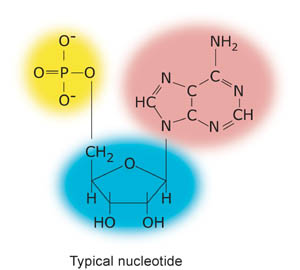Nucleic Acids
Nucleic Acids are polynucleotide polymers of monomers referred to as nucleotides. A nucleotide is itself built of three components: a phosphate, a sugar and a nitrogenous base.

Figure 11. Typical nucleotide structure displaying the phosphate highlighted in yellow, and the sugar (in this case ribose) in blue, and the base in pink.
Also broken down by hydrolysis, a nucleic acid is a polymer that is formed through the dehydration of nucleotides. When these monomers join together, the bonds form between the sugar and the phosphates. Thus, nucleic acids have a sugar-phosphate-sugar-phosphate backbone with the nitrogen bases "sticking out".
Dehydration of Nucleic Acids
In the dehydration of nucleic acids, a hydrogen (-H) from the phosphate group (-H2PO4) of one nucleotide combines with a hydroxyl group (-OH) (illustrated by adding glue) from the sugar of another nucleotide. When the hydrogen and hydroxyl group join water is produced, and the two nucleotides are officially stuck to each other.
![]()
![]()
Animation 5. Dehydration of Nucleic Acids (opens Youtube in new window).
Hydrolysis of Nucleic Acids
The nucleic acid is broken apart using a water molecule (represented by scissors cutting the nucleic acid into two pieces). This bond is broken, by adding one hydrogen atom (-H) and one hydroxyl group (-OH) to each monomer subunit.
Animation 6. Hydrolysis of Nucleic Acids (opens Youtube in new window)


